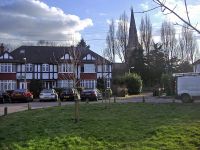Kingsbury is a district of northwest London in the London Borough of Brent. Its ancient scope stretches to include various distinct areas that were once small villages until the inter-war period. Kingsbury was in 2001 a ward and in 2011 was identifiable with the Fryent and Barnhill wards approximately. Today it forms a quiet suburb between Fryent Country Park to the west and the Brent Reservoir to the east, along with a Jubilee line tube station and accompanying shopping district on the western side. The postal district is NW9 which it shares with Colindale and West Hendon.
History
Kingsbury was historically a rural parish of a fairly modest 6.9 square kilometres (2.7 sq mi) in the Hundred of Gore and county of Middlesex. It formerly included Queensbury. Following local government redrawing of electoral wards Kingsbury corresponds to the Fryent and Barnhill wards and in all of its various older guises, a minority or all of the Queensbury ward.
The early English kings had parted with their manor of Kingsbury long before the Conquest. An estate called Tunworth, in the northern part of Kingsbury parish, was granted by Edwy to his thegn Lyfing in 957. By 1066 it probably formed part of the manor of Kingsbury, which was then held by Wlward White, a thegn of the Confessor, and passed from him to Ernulf of Hesdin who died in 1097 and his lands passed to the family of Walter of Salisbury. Thereafter the overlordship of Kingsbury descended with Edgware manor. By 1086 on the Domesday survey of property, Ernulf's manor in Kingsbury had been subinfeudated to Albold as Lord. It was not mentioned again until 1317, when, under the name of the manor of Kingsbury, it belonged to Baldwin Poleyn of Tebworth.
Kingsbury developed little in housing and population in the 19th century, remaining a polyfocal village. In this age, Oliver Goldsmith, writer and playwright, lived at Hyde Farm, Kingsbury (1771–1774); the third Lord Mansfield was buried at St. Andrew's churchyard in 1840.
Although it lay clos
